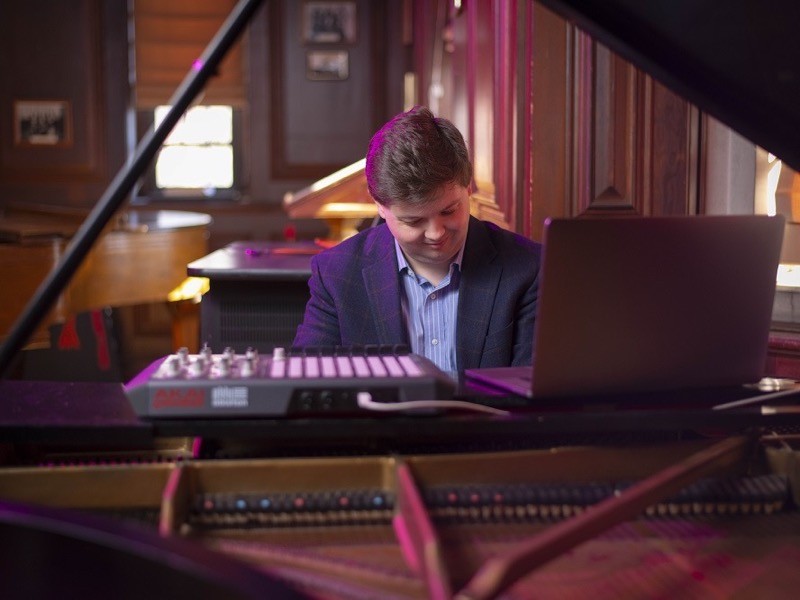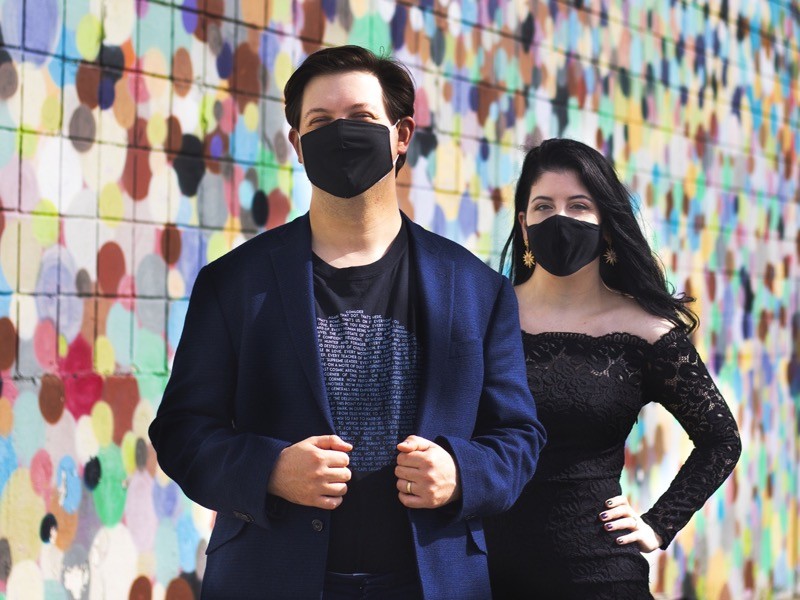As a composer, and the director of the Multiverse Concert Series — a non-profit organization that combines music and science in live performances — I strive to create musical metaphors for the dreams and details of science to share with an audience. I think that bringing artists and scientists together on the stage can help them to communicate the complex beauty of our world in a language that everyone can understand and appreciate.
In January 2020, I was thrilled to be invited to be the first guest composer at Fermilab, a national laboratory in Batavia, Illinois, that specializes in high-energy particle physics. The original residency was to have lasted a year, culminating in a live concert in the lab’s Ramsey Auditorium at the beginning of this year. However, because the coronavirus pandemic has put live performances on hold, I’ve been focusing on creating music videos inspired by the lab’s work that can be shared digitally and in live-streamed performances. This online format is perhaps a silver lining, because it has helped us to reach people all over the world, and I’ll continue working on the project — which we’ve dubbed Neutrino Music — until we can perform live once more.
As a child growing up in Coventry, UK, I enjoyed visits to my dad’s lab at Courtaulds Textiles as fun adventures into the world of science. He would show my brothers and me fibrous polymers being wound, cooked and stretched, sometimes giving us prototype Tencel socks to take home. These experiences stayed with me, but were pushed to the back of my mind as I trained as a musician (after my mother). By the age of 17, I was squarely on the arts track, and was encouraged to drop all science and mathematics courses to focus on music, literature and languages.
Fast-forward to 2015, when I finished my doctorate in composition at the University of Birmingham, UK, and found myself deeply engaged in technical pursuits. My composing had dived into music programming and sonification — the process of translating data into sound — and I had to race to shore up my basic science to meet these creative demands. Ultimately, it was my graduation piece, Europa for flute and electronics, that united music and science in my life. Cast as a tone poem — a piece of orchestral music in a continuous section — the piece charts an imagined journey to Jupiter’s moon of the same name in search of extraterrestrial life beneath its icy surface. Flautist Karin de Fleyt and I toured the piece around Europe, and it was a joy to see audiences’ reactions to a science story told through music.
Since then, most of my compositions have been connected with science, and I founded the Multiverse Concert Series in 2017 as the home for a diverse array of collaborations with scientists and labs.
When you ask a scientist or an artist about their work, they often talk of big questions that remain unanswered, ambitious goals that they hope to pursue in their next project and, if you listen long enough, lengthy accounts of the monumental dedication required by all involved. Music strives to be meaningful, to build connections and to make the world a better place. Scientists need to communicate their work, but are often limited to discussing it with their immediate colleagues, who can understand the theoretical roots of the questions at the heart of the endeavour. I think that, together, our disciplines can transcend the boundaries and make a profound difference in society.
Tackling the very small with the very big
Table of Contents
As Fermilab’s first-ever guest composer, I have seen my writing catapulted into new levels of complexity that require novel compositional tools to share the unfolding science stories. I was able to visit the facilities in early 2020 and tour some of the many experiments under construction. What continues to amaze me is that to study the very small, we must build machines of increasing magnitude. Fermilab operated what was once the world’s largest particle accelerator, and is now leading the construction of one of the world’s most technologically advanced neutrino detectors: the Deep Underground Neutrino Experiment (DUNE).
Neutrinos have been on my mind since my first conversations with Fermilab physicist Don Lincoln, in January 2020. These subatomic particles could hold the key to many mysteries — from fundamental laws of physics to the nature of dark matter.
I decided to launch a project diving into the most intriguing of neutrino properties: oscillation. There are three different kinds, or ‘flavours’, of neutrino — electron, muon and tau — and physicists can predict which type will be produced in a particular particle interaction. However, the flavour can change as the neutrinos travel through space, in a process of oscillation governed by quantum mechanics.
This is in itself incredible, because the standard model of physics predicts that neutrinos are massless, and therefore incapable of change. Neutrino oscillation has been observed in multiple experiments, so the particles must have mass, and this knowledge has profound implications. If neutrinos oscillate in different ways from their antimatter counterparts, it could account for the imbalance of matter and antimatter in the early Universe — ultimately giving rise to the matter-dominated Universe we live in today through a process called leptogenesis.
I wanted to create a composition that translated these phenomena into music, with the hope of shedding light on the true nature of the fascinating quantum world. I began by sonifying a model for neutrino oscillation that shows the probabilities of an electron neutrino oscillating into a muon or tau neutrino at particular distances from the source (see go.nature.com/3jsh5pk). In my composition, Particle of Doubt, these probabilities are sonified as melodies for violin, viola and cello, with a higher-probability chance corresponding to a higher-pitched note.
To quantize the smooth data into musically playable notes, I chose a musical scale associated with drive and urgency: the Dorian mode, which was first used by the ancient Greeks and is still strongly evocative to the modern ear. The Dorian is similar to the familiar minor scale, but has a major lift on the sixth degree, which is suggestive of courage and hope. To provide a sense of rhythm, I introduced an uneven swing, giving the impression of perpetual instability. With the sonification complete, I began expanding the composition by adding piano, percussion and voice to explore the broader mysteries of the neutrino and their ramifications. Soprano Beth Sterling sings:
You should be massless
Like rays of light.
You should be changeless,
But the change gives us hope
We’ll know where we came from.
My Fermilab work is ongoing, and the road map for the project is leading me to create a full concept album, titled Neutrino Music, about the lab’s quest to understand the neutrino. This will be my second such album, after Octave of Light, which was released last November.
Octave of Light is a musical celebration of exoplanet science — the study of planets beyond our Solar System — and was inspired by the work of Roy Gould at the Harvard-Smithsonian Center for Astrophysics in Cambridge, Massachusetts. In my own lifetime, scientists have discovered more than 4,000 exoplanets, many of these through a technique called the transit method, which tracks the shadows cast by a planet as it passes in front of its parent star.
Analysing these shadows reveals a range of colours in the electromagnetic spectrum. Sadly, these colours are beyond the range of human vision, but it is possible to hear them as musical notes through sonification. These spectra and their musical chords reveal not just the colour of a planet, but the chemical make-up of its atmosphere and — perhaps — its potential for life.
I plan to chart a similar musical journey with neutrino science, tracing an arc from oscillations to dark matter, supernovae and physics beyond the standard model. The lab could not be more supportive of my project as it unfolds. We premiered the composition MicroBooNE in the lab’s online lecture series in December by Fermilab scientist Bonnie Fleming, and we will continue to present compositions in online events until the complete album can be performed live.
Fermilab is entering uncharted waters of physics, and its quest to understand the neutrino is a journey that we can all undertake together. Hard science is challenging to share, and music can help to reveal not just the intellectual, but also the emotional depth of the work being done in a language that communicates beyond the boundaries of education. Neutrinos — small as they are — display amazing behaviours, and have a fundamental role in the nature of our Universe.
With an introduction to the neutrino’s mysteries through music, I hope that more of us can marvel at the revelations coming out of Fermilab as DUNE begins to produce its data.


